Posts Tagged: pomegranate
Time to 'Bee' Thankful
It's Thanksgiving Day, and as we sit down with family and friends to count our blessings, let's thank the bees. If your table includes pumpkin,...
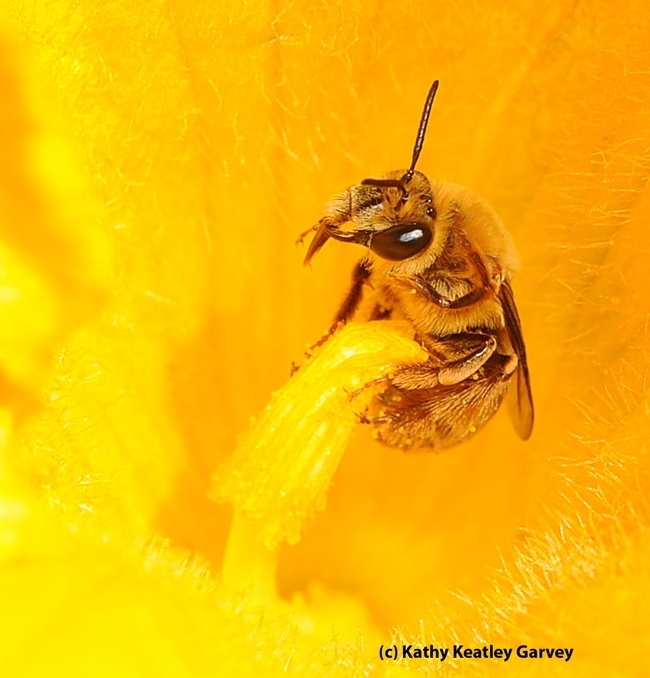
A squash bee, Peponapis pruinosa, pollinating a squash blossom. (Photo by Kathy Keatley Garvey)
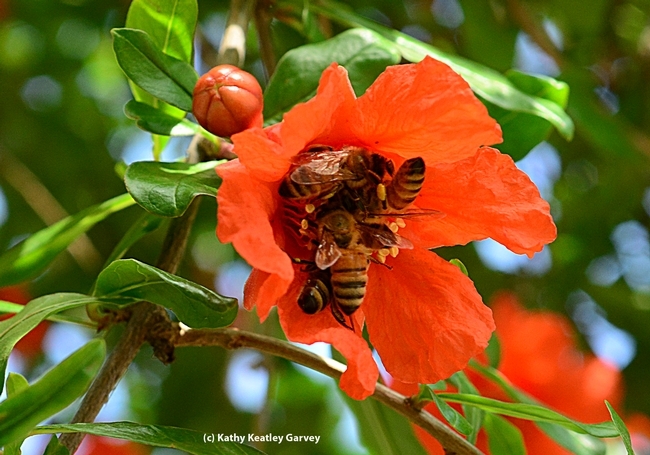
Five honey bees offering their pollination services on a pomegranate blossom. (Photo by Kathy Keatley Garvey)
May the Fourth Be With You
"The Redcoats are coming! The Redcoats are coming!" So shouted American Revolutionary patriot Paul Revere during his historical ride. Those who...
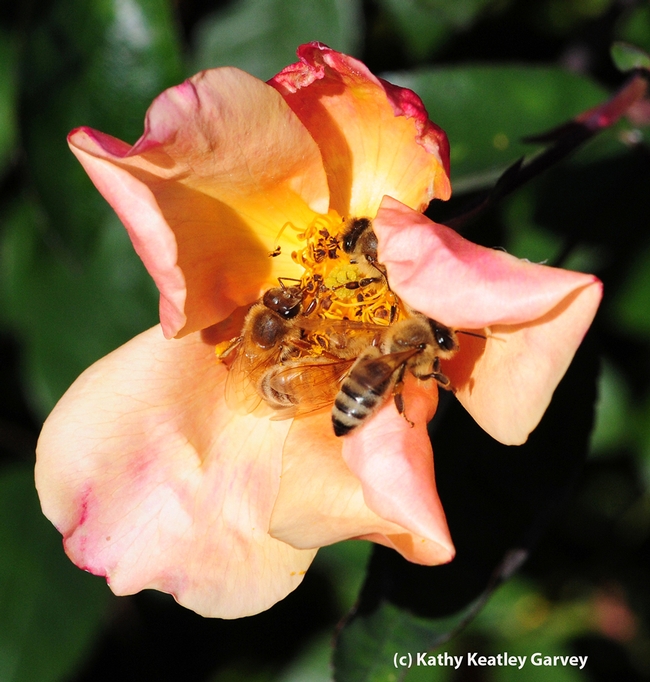
May the Fourth Be With You: Four honey bees share a rose blossom. (Photo by Kathy Keatley Garvey)
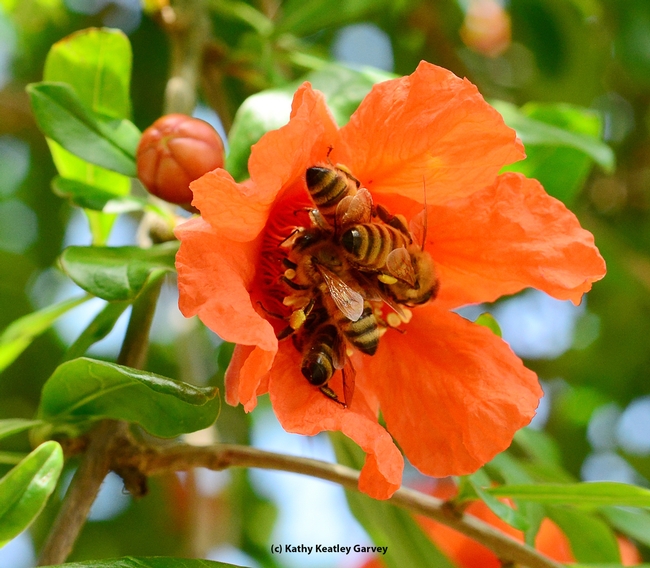
May the Fourth Be With You: Four honey bees share a pomegranate blossom. (Photo by Kathy Keatley Garvey)
The Taste of Honey--Pomegranate Honey
Last spring you may have seen honey bees pollinating the showy pomegranate blossoms. The ancient fruit, first cultivated around 4000 B.C. in Persia...
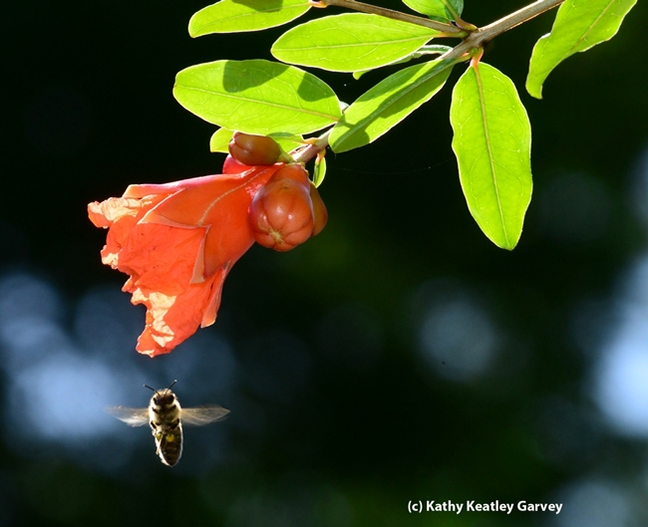
A honey bee heads toward a pomegranate blossom. (Photo by Kathy Keatley Garvey)
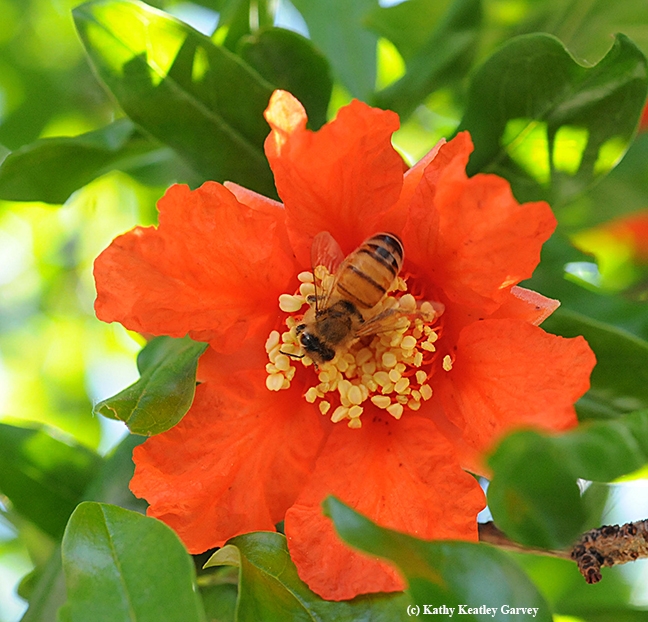
A honey bee pollinating a pomegranate blossom. (Photo by Kathy Keatley Garvey)
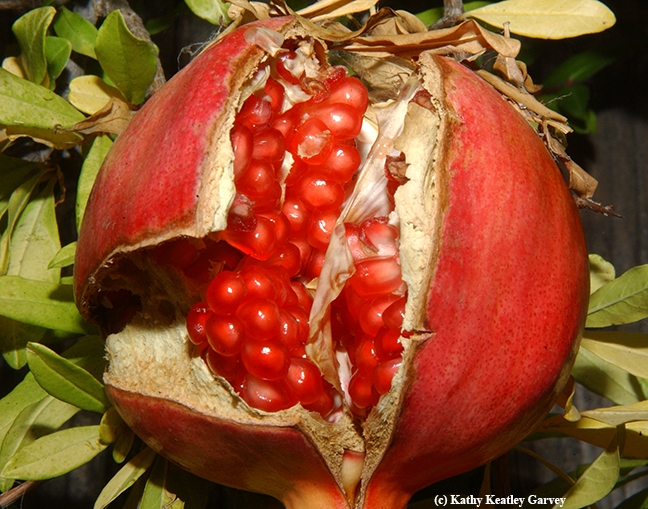
This is what the bees did! A mature pomegranate full of ruby red seeds. (Photo by Kathy Keatley Garvey)
Where the Bees Are
Do you now where the bees are? On Thursday, May 8 let's all step outside for three minutes and count the honey bees and other...

Honey bees clustering on pomegranate blossom. (Photo by Kathy Keatley Garvey)
Pomegranate
A pleasure of the autumn garden is the sight of a pomegranate bush with its multiple red fruit in contrast against its still green foliage. Late September is the time that pomegranates ripen in our area and the fruit and juice can be used in many recipes from salads to dessert. The bright red fruit also make colorful additions to autumn displays from table decorations to wreaths.
Pomegranates, Punica granatum, originated in Iran and have spread throughout the Middle East and areas with a Mediterranean climate including California. They are both colorful and drought resistant. Pomegranates grow as a bush or small tree and can reach a height of 10 to 16 feet but can be kept smaller with judicious pruning. The bushes are generally deciduous and bright scarlet flowers appear among young leaves in spring. The set fruit appears as relatively inconspicuous globes until late summer when the exocarp or covering turn a deep red. When ripe, the fruits are generally between three and five inches in diameter with a distinctive calyx. Pomegranates are harvested by clipping the fruit just above the stem end rather than by pulling or twisting. While pomegranates are beautiful on the bushes, they should be picked before autumn rains since the excess water will split the exocarp and spoil the fruit. Pomegranates can be stored under refrigeration for up to seven months but will dry out over time if left at room temperature.
Pomegranates are easily planted as bare root plants in early winter and many cultivars are available from local and mail order nurseries. The cultivar Wonderful is the primary commercial variety in California. A light harvest is available from the second year on and mature bushes are highly productive. Pomegranates are relatively disease and pest free. The fungal diseases Alternaria fruit rot and Aspergillus fruit rot can appear if rain occurs during bloom and grey mold, Botrytis cinerea can occur on harvested fruit. The primary insect and mite pests of pomegranates are aphids, omnivorous leaf roller, leaf footed bugs and citrus mites, The greatest threat to pomegranate bushes in home orchards comes from vertebrate pests including gophers and ground squirrels which scour roots and girdle trunk stems. A gopher cage is effective measure to allow a young bush to grow without interference.
Pomegranate fruit are actually berries. The red, fluid filled arils that surround individual seeds are held in place by a fibrous membrane. The sweet, bright red arils can be used in salads, smoothies, desserts or any recipe that can use a bright sparkle. Many Iranian and Middle Eastern recipes use pomegranate arils, juice or a molasses-like reduction of the juice for flavor and sweetness. Pomegranates and their juice are a good source of Vitamins C and K and contain antioxidants including ellagitannins and punicalagins. The arils are a source of dietary fiber.
To open a pomegranate, slit the side with a knife and then plunge the fruit into a bowl of water. Gently open the fruit with your fingers and twist to separate the arils from the membrane that surrounds them. The water will prevent the juice from staining the surrounds and will facilitate separation of the arils which sink while bits of membrane and exocarp will float. Remove any floating debris and pour the contents through a colander or sieve to separate the arils. The collected arils can be used “as is” or they can be juiced. Pomegranate juice is the red fluid between the seed and the aril wall. Use a hand press juicer (i.e. a citrus press) rather than a centrifugal or grinding juicer to avoid breaking the white seeds open and imparting a bitter flavor to the juice.
References:
UC Davis Fruit and Nut Research and Information Website for Pomegranates (2013)
http://fruitandnuteducation.ucdavis.edu/education/fruitnutproduction/Pomegranate/
Pomegranate Fruit Facts (1997) - California Rare Fruit Growers
http://www.crfg.org/pubs/ff/pomegranate.html

Pomegranate shrub with beautiful ornamental fruit. (photos by Rich Zimmerman)
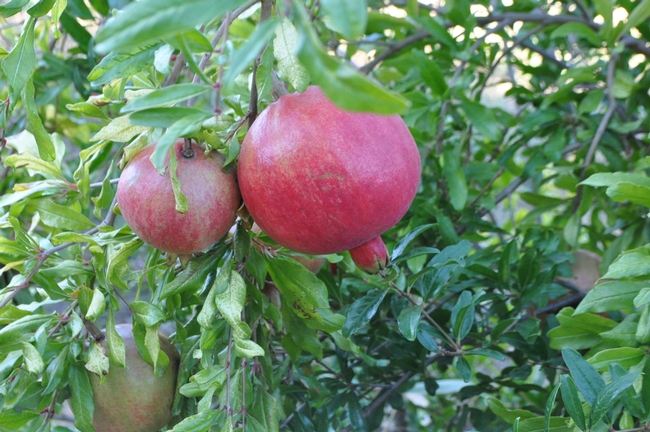
Red globes.

The red jewels inside.

